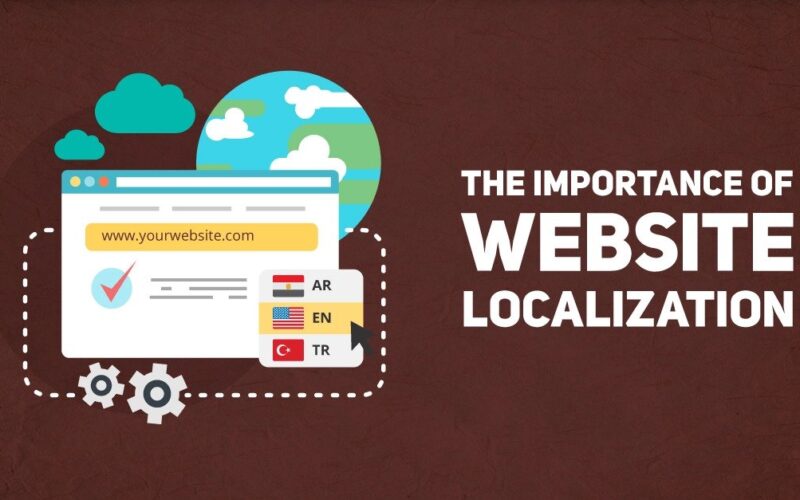Your website serves as your company’s digital front door, and it must make visitors feel welcome. The reality is that a website can make or break a worldwide brand, which is why some of the world’s most well-known companies, like Nike, McDonald’s, Microsoft, and Apple, have all made significant investments in website localization.
What is Localization?
The practice of adjusting your website to the culture and language of consumers in a target market is known as website localization. People all across the world are considerably more inclined to buy from a website that addresses them in their native language. Even if the material is of low quality, 65% of customers prefer it in their native tongue.
However, launching a multilingual website is more than just reproducing your original material verbatim in another language. It entails considering cultural variations, regulatory constraints, shopping patterns, and payment methods, to mention a few parts of a complicated process like website localization.
If you’re feeling overwhelmed by the process ahead, don’t worry: website localization doesn’t have to be a pain. If you’re searching for the best approach to localizing a website, this guide will help you avoid typical localization blunders, publish your multilingual website fast, and provide an excellent user experience (UX) for your worldwide users.
Different factors of website localization
Translation of material into target languages is one of the most important ways to communicate with local markets in different nations. However, localization is more than just translation. While translation is important in the localization process, additional factors for a translated website include:
- Changing visuals, movies, graphics, and even emojis to appeal to the target audience
- Content may be fine-tuned to meet ethnic, religious, or general tastes.
- Changing the website’s design, structure, and formatting to accommodate translated contents that read from right to left
- Local currencies and units of measurement are available.
- Date formats and phone numbers are being localized.
- Using proper naming rules, as various languages arrange first and last names differently.
- Following local legislation and legal requirements
A good localization workflow, in essence, includes all of the activities necessary to maximize the user experience of a certain consumer group in a specific country.
Why should you localize your website?
Localization allows you to communicate with your new audience on a more meaningful level than mere translation. This result in stronger bonds increased loyalty and increased consumer pleasure. You may benefit from localization by doing the following:
- Expand into new markets
Not every product or service is a natural match for new markets in its original form. McDonald’s would have struggled to penetrate the Indian market if it had not promoted chicken and paneer burgers. The majority of Indian consumers do not eat beef. Starbucks suffered an expensive failure in Australia by failing to cater to local coffee preferences.
You may hit the ground running in new markets across multiple nations by paying attention to the demands of your new target audience and employing appropriate localization procedures. Good localization includes avoiding cultural misconceptions that might harm your brand.
- Obtain a competitive advantage
Businesses that localize their offerings outperform those that neglect local cultural norms and demands. Localization allows you to keep your firm innovative and competitive in a congested market.
- Enhance the User Experience
Nobody enjoys visiting a website only to discover that it contains missing characters, text that displays strangely, and visuals in a foreign language. Visitors used to English pubs will be perplexed if you launch a branch of your Chinese bar chain in the UK. Customers who are interested in your clothing line will be turned off if they don’t comprehend the sizes you provide.
- Increase Customer Loyalty
People are most loyal to companies and services that they believe genuinely care about them and their needs. A transaction with “Faceless MegaCorp (TM)” will not inspire loyalty; yet, a transaction with an E-commerce company that knows local traditions, holidays, and other oddities will seem far more natural and encourage people to return again and again. And this eventually leads to desire decisions.
- Boost your revenue
You’ll have no issue selling in new areas to new and potential clients if you have the correct content localization plan. This allows you to optimize your business and increase your income.
After all, the Localization Industry Standards Association (LISA) recently published research that found that every €1 invested in website localization produces €25 in return.
Website Localization Suggestions
As website translation is a difficult process, there are several frequent challenges that your team may encounter. Here are some pointers to remember throughout the procedure.
- Consider your website’s layout carefully
Another facet of the relevance of user experience is different reading styles. While English speakers read from left to right, Arabic speakers read from right to left. When entering new markets, adapting your website layout to accommodate natives has a great impact and leads to direction.
- Plan for text expansion and minimization
When translating text from English into another language, you can almost always expect it to take up more space. Make your website adaptable to changes in text allowance, and use readily translatable typefaces.
For a more clear translation, consider the following:
MS Arial Unicode (Sans Serif)
Numerous Advantages (Sans Serif)
Times New Roman font (Serif)
- Make all site features, including multimedia, available in many languages
Remember to localize and translate all multimedia assets, including videos and infographics, as well as any website content. Localization of video is a challenging process, yet it is worthwhile: 72% of purchasers would rather watch a video about a product or service than read about it.
In addition to translating text, perform an image audit on your website. While a photograph may appear benign in one culture, it may cause misunderstanding or alarm in another. Your team should carefully examine photo aspects including dress choices and hand movements. You should also consider translating alt tags to make photos more accessible.
- Avoid using graphics with text
Changing text contained in a picture is substantially more difficult (and occasionally impossible). It is best practice to avoid including images with textual statements.
Create a translatable text layer if you want to include text in your photographs. To make picture text translation much easier, use coding such as CSS.
- Reduce content load-time
Not every country has superfast internet. Conduct some research on connection speeds in the countries where you intend to expand. Then, make the necessary changes to your website’s content.
For instance, if your website has high-resolution photographs, it will considerably slow down page load speeds for people with poorer connections. Reduce picture sizes to minimize load time to mitigate this.
- Create a comprehensive style guide.
To make localization more successful, create a style guide to ensure uniformity in aspects such as date, font, currency, and punctuation standards. You may assist maintain consistency in your multilingual website by establishing certain standards, such as whether a given area utilizes a 12-hour or 24-hour time style.
- Give your translators background
Provide context to your translators to improve the effectiveness of their translations. It is often tempting to move rapidly and believe that your translators will get the meaning of each piece of text. Instead of scrimping and leaving your translator in the dark, take screenshots, take notes, and give support if questions occur.
- Do not mix up language and country
Rather than relying just on language, widen your localization strategies by taking into account the cultural effect of location and nation. The term “locale” relates to both language and area, allowing your website to adjust more comprehensively and reasonably.
For example, if you merely select English as a language code and ignore regional variances, your price units will be incorrect for various English-speaking regions of the world. Coding by location will make it easy for New Zealanders to see NZD pricing and Euros for Irish users.
- Make switching between languages simple
Visitors to your website should be able to simply choose between languages. Just make sure that your branding and design aspects are constant across each translation, as well as your links, titles, and headers.
Many websites use a globe symbol to link viewers to different translations—this is a far better icon than flags because one country may have many different languages. Refer to different options in the local language when listing languages. For example, instead of “Japanese,” say “.”
- Integration of automated translations
You can automate translation for most of your website content by linking your CMS with a translation management system. Automated translation is a quick and straightforward approach to translating vast amounts of text, such as product descriptions and services.
While translation management systems can swiftly translate hundreds or thousands of support articles for approval, copywriters can handle important landing pages like your homepage. This hybrid strategy will assist in properly localizing your website’s main parts while also speeding up the long tail of pages featured on your site.



